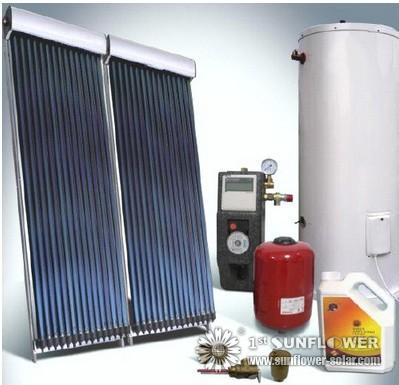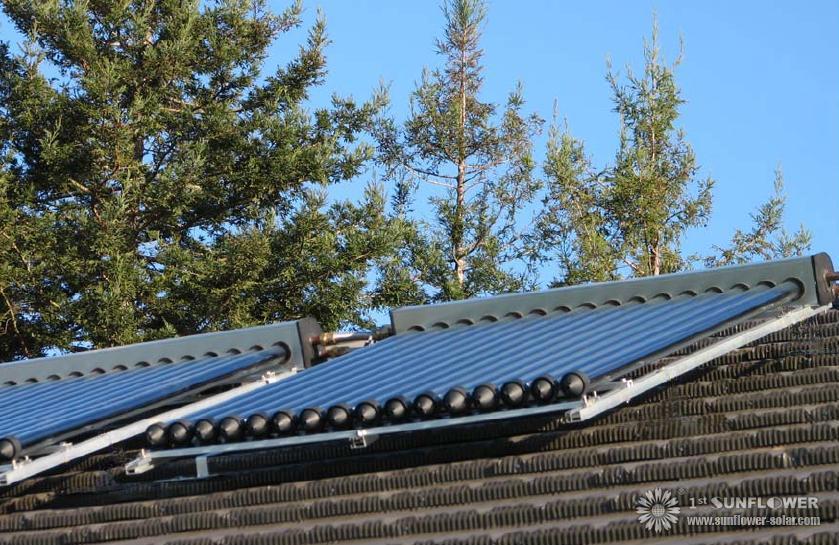The Use of Heat Exchangers for Solar Water Heating Systems
Author:None
From:None
Post time:03/31/2012
View:4798
Solar water heating systems heat exchanger solar energy in solar collectors absorb which used liquid or air, to water or space heating to transfer.

Solar water heating systems heat exchanger solar energy in solar collectors absorb which used liquid or air, to water or space heating to transfer.
Heat exchangers can be made of steel, copper, bronze, stainless steel, aluminum or cast iron. Solar systems use copper, and greater resistance to corrosion usually because it is a good heat conductor.
Types of Heat Exchangers
Solar water heating systems use three types of heat exchangers:
Liquid-to-liquid
This heat exchanger uses a Wärmeübertragungsfluid which circulates through the solar collector absorbs heat and then passes through a heat exchanger to transfer its heat to water in a reservoir. Heat carrier fluids such as antifreeze, protect the solar collector from freezing in cold weather. Liquid-to-liquid heat exchanger are equipped with either one or two barriers (einwandig or double-walled) between the heat carrier and the domestic water supply.
Give to a tube or a tube of a liquid a single-heat exchanger. Either the fluid, through the hose or the liquid around the pipe can to be fluid while the other drinking water the heat-transport fluid. Double wall heat exchangers have two walls between the two fluids. Two walls are often used when the Wärmeübertragungsfluid is toxic such as ethylene glycol (antifreeze). Double walls are often needed as a security measure in the case of leakage, helps to make sure that to mix the antifreeze with water supply. An example of a double-walled, liquid-to liquid heat exchanger is the "wrap around heat exchanger", in which a tube is wrapped around and with the outside of a hot water tank. The pipe should be isolated enough to reduce heat loss.
While double wall heat exchangers increase the security, they are less efficient, because the heat must by two surfaces as to transfer. To transfer the same amount of heat, a double-walled heat exchangers must be greater than a single-exchanger.
Air-to-liquid
Solar systems with heating must normally not a heat exchanger between the collector and the distribution of air collectors. These systems with heating collectors heat air liquid heat exchangers, which are similar to fluid air heat exchanger water use.
Heat exchanger design
There are many heat exchanger designs. Here are some most common:
Coil-in-tank
The heat exchanger is a pipe snake in the storage tank. It can be a single tube (single-heat exchanger) or the thickness of the two pipes (double-walled heat exchangers). A less effective alternative is to the coil on the outside of the bulk container with a cover of the insulation.
Shell-and-tube
The heat exchanger is separate from (external to) the storage tank. It has two separate fluid loops inside a case or shell. The fluids flow in opposite directions to each other through the heat exchanger, maximizing heat transfer. In one loop, the fluid to be heated (such as potable water) circulates through the inner tubes. In the second loop, the heat-transfer fluid flows between the shell and the tubes of water. The tubes and shell should be made of the same material. When the collector or heat-transfer fluid is toxic, double-wall tubes are used, and a non-toxic intermediary transfer fluid is placed between the outer and inner walls of the tubes.
inside a case or shell. The fluids flow in opposite directions to each other through the heat exchanger, maximizing heat transfer. In one loop, the fluid to be heated (such as potable water) circulates through the inner tubes. In the second loop, the heat-transfer fluid flows between the shell and the tubes of water. The tubes and shell should be made of the same material. When the collector or heat-transfer fluid is toxic, double-wall tubes are used, and a non-toxic intermediary transfer fluid is placed between the outer and inner walls of the tubes.
Tube-in-tube
The pipes of water and the heat carrier in direct thermal contact with each other are very efficient in this design. The water and the heat transfer fluids in opposite directions to each other. This type of heat exchanger has two loops similar to those in the cloak and tube heat exchanger described.
Sizing
A heat exchanger must be sized correctly to be effective. There are many factors to consider for proper sizing, including the following:
Type of heat exchanger
Characteristics of heat-transport fluid (specific heat, viscosity and density)
Flow
And outlet temperatures for each fluid.
Usually the manufacturers will heat transfer to provide reviews for their heat exchangers (in BTU / hour) for different temperatures and fluid flow rates. Also the size effect of a heat exchanger area its speed and efficiency: a large surface transfers heat faster and more efficiently.
Installation
For the best performance, always recommendations for the heat exchanger follow the installation instructions of the manufacturer. Sure, a heat-conveying liquid compatible with the nature of the heat exchanger you will use is to choose. If you want to build your own heat exchanger, be aware that the use of different metals in the heat exchanger can design cause corrosion. Also, because different metals of different thermal expansion and contraction have, there may be leaks or cracks develop. Each of these conditions can reduce the lifespan of your heat exchanger.
inside a case or shell. The fluids flow in opposite directions to each other through the heat exchanger, maximizing heat transfer. In one loop, the fluid to be heated (such as potable water) circulates through the inner tubes. In the second loop, the heat-transfer fluid flows between the shell and the tubes of water. The tubes and shell should be made of the same material. When the collector or heat-transfer fluid is toxic, double-wall tubes are used, and a non-toxic intermediary transfer fluid is placed between the outer and inner walls of the tubes.